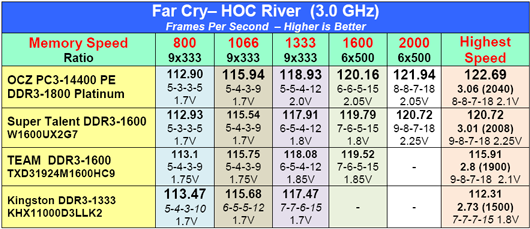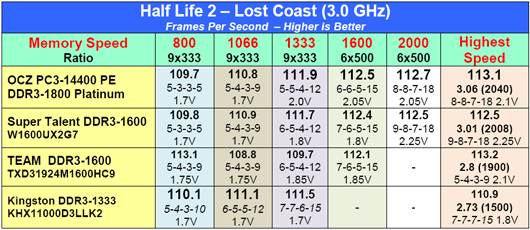Gaming
Three DX9 games representing different gaming engines were used to test the performance of the OCZ DDR3-1800 Platinum in real world gaming. There are more recent gaming titles available, but they are also DX9. We will update games in the memory test suite as soon as a selection of DX10 games with reliable benchmarks is available. At that time the memory test OS will also be moved to Vista.
The Far Cry - River demo was run for three loops and results in FPS were averaged over the three runs. ALL games were run at 1280x1024 resolution, which is the maximum resolution for the most common 19" flat panel monitors.
The Kingston tops performance at the slower DDR3-800 speed, but the Micron Z9-based memory takes top honors from 1066 to the Highest Speed DDR3. OCZ manages the best performance at those speeds with slightly faster timings than other Z9-based memory.
Quake 4 and the underlying engine have always proved to be very sensitive to improvements in memory bandwidth. This is amply demonstrated in these memory tests. Kingston, based on Elpida LL memory, performs best at the slower 800 and 1066 speeds, with OCZ and the other Z9 memory topping DDR-1333 to DDR3-2000. The pattern is basically the same as in Far Cry. With the constant CPU speed of 3.0GHz we see frame rates improve from 116.8 at DDR3-800 5-3-3 to 128.7 at DDR3-2000 9-8-7, an improvement of just over 10%. We have commented many times that memory is just one small part of the performance equation, but a 10% improvement in a game frame rate merely as the result of an increase in memory speed (and FSB speed, though we can't isolate that factor at present) is significant. Far Cry sees a similar increase from 112.90 at 800 to 121.94 at DDR3-2000, which is about an 8% improvement.
We include Half-Life 2: Lost Coast as a representative of games that are less sensitive to improvements in memory bandwidth. Lost Coast is played through the Steam engine, where there is the constant worry, for a reviewer, that each new update of Steam will break your test benchmarks. Though the differences are very subtle and HL2 performance is most influenced by the video card and CPU used in the benchmark, there are nonetheless patterns that are the same as the other two games. The Kingston wins by a small margin at 800 and 1066, while the OCZ tops the performance of Lost Coast from 1333 to 2000+. This game is not very sensitive to memory bandwidth so it is no real surprise that the performance improvement form 800 to 2000 is a small 3%.
Three DX9 games representing different gaming engines were used to test the performance of the OCZ DDR3-1800 Platinum in real world gaming. There are more recent gaming titles available, but they are also DX9. We will update games in the memory test suite as soon as a selection of DX10 games with reliable benchmarks is available. At that time the memory test OS will also be moved to Vista.
The Far Cry - River demo was run for three loops and results in FPS were averaged over the three runs. ALL games were run at 1280x1024 resolution, which is the maximum resolution for the most common 19" flat panel monitors.
 |
| Click to enlarge |
The Kingston tops performance at the slower DDR3-800 speed, but the Micron Z9-based memory takes top honors from 1066 to the Highest Speed DDR3. OCZ manages the best performance at those speeds with slightly faster timings than other Z9-based memory.
 |
| Click to enlarge |
Quake 4 and the underlying engine have always proved to be very sensitive to improvements in memory bandwidth. This is amply demonstrated in these memory tests. Kingston, based on Elpida LL memory, performs best at the slower 800 and 1066 speeds, with OCZ and the other Z9 memory topping DDR-1333 to DDR3-2000. The pattern is basically the same as in Far Cry. With the constant CPU speed of 3.0GHz we see frame rates improve from 116.8 at DDR3-800 5-3-3 to 128.7 at DDR3-2000 9-8-7, an improvement of just over 10%. We have commented many times that memory is just one small part of the performance equation, but a 10% improvement in a game frame rate merely as the result of an increase in memory speed (and FSB speed, though we can't isolate that factor at present) is significant. Far Cry sees a similar increase from 112.90 at 800 to 121.94 at DDR3-2000, which is about an 8% improvement.
 |
| Click to enlarge |
We include Half-Life 2: Lost Coast as a representative of games that are less sensitive to improvements in memory bandwidth. Lost Coast is played through the Steam engine, where there is the constant worry, for a reviewer, that each new update of Steam will break your test benchmarks. Though the differences are very subtle and HL2 performance is most influenced by the video card and CPU used in the benchmark, there are nonetheless patterns that are the same as the other two games. The Kingston wins by a small margin at 800 and 1066, while the OCZ tops the performance of Lost Coast from 1333 to 2000+. This game is not very sensitive to memory bandwidth so it is no real surprise that the performance improvement form 800 to 2000 is a small 3%.










25 Comments
View All Comments
Mithan - Wednesday, August 1, 2007 - link
I am guessing these games were run at 800x600, which is fairly standard for memory tests?IF that is the case, then all this article does is prove once again why over-spending on memory is not the best use of your dollars (except in the case of over-clocking)
My point is this:
Farcry going from 112 to 122 FPS is probably being done at 800x600 or 1024x768.
Bump that resolution up to 1600x1200 or 1920x1200, and that becomes 1 or 2 frames per second difference.
My point is that the article should articulate this difference better.
MadBoris - Wednesday, August 1, 2007 - link
From a testing perspective of any hardware among each other, you have to isolate and remove the other bottlenecks. That should be done and is of course common sense. As you state, the main goal of these types of articles should at their very foundation stay focused on real world performance impact. Otherwise it looks too much like technology promotion and they lose their actual value to the reader. They don't have to go "real world" overboard, but I think that should be the consistent goal of hardware reviews.
Test info would be nice.
In the same vein of real world impact, the comparison should never have been between DDR3@800 compared to DDR3@2000. That's not even really applicable, the upgrade path isn't from DDR3 800, so I am not sure why the particular comparison was even made. The comparison at the very least, needs to be to current DDR2 offerings. The best case performance that DDR3 can provide right now is actually around 3 - 5 percent from current DDR2 offerings under those specific game tests (as I mentioned earlier), whatever those settings were.
Obviously testing these memory comparisons isn't simple from an apples to apples standpoint especially with limited time, so I am just glad Anandtech is getting in there and doing the testing and making their findings known. :)
Wesley Fink - Wednesday, August 1, 2007 - link
Factoring in the slower performance of current 965/975 boards on p.4 of the article, you will see that DDR3-800 on the P35 clearly beats DDR2-800 on the P965 platform. In fact, DDR3 is generally faster than DDR2-1066 at 4-4-3 timings on the P965 (the only exception being Far Cry). Taking that into account our broad statement that current DDR3 can provide as much as an 8% to 10% real world performance improvement over current DDR2 systems is certainly fair.Wesley Fink - Wednesday, August 1, 2007 - link
DDR2-800 is the fastest official JEDEC spec for DDR2, and memory running at 3-3-3 at that resolution is common among better DDR2. It is among the fastest DDR2 performance due to the fast timings. The fastest DDR2 can reach 1066 at slower timings but it cannot reach 1333.Similarly we would compare to DDR-400 at 2-2-2 looking at DDR, since this was the fastest JEDEC speed looking back at DDR. DDR3 starts at 800 and goes officially at the present time to DDR3-1600. It will likley go higher in the future.
We have compared DDR3 to one of the fastest DDR2 memories ever made at the fastest timings available for DDR2 at both 800 and 1066 in the overlap speed results on p. 4. We also did not really factor in the fact that DDR2 runs slower on the P965, P975, and other current boards than it does on the DDR2 version of the current P35 chipset.
NegativeEntropy - Tuesday, July 31, 2007 - link
I read through the article and (quickly) double checked the test config and gaming pages, but I did not see the settings the games were tested at?Wesley Fink - Wednesday, August 1, 2007 - link
All games were run at 1280x1024. That has been in past commentary, but was dropped somewhere along the way. We will add that info to the game results page.Jodiuh - Wednesday, August 1, 2007 - link
Unfortunately, you're right in the $$ issues. Those of us that would be willing to pay 2-3 times the amount for 10% gaming improvement would be better off w/ a better GPU, or even a Q66/X32 CPU for games like Supcom.Would you mind guessing what perf improvement would come from running @ say 1600x1200 or greater + 8xQ/6x AA? It'd be even less, no?
chizow - Tuesday, July 31, 2007 - link
Another underwhelming and unnecessary "update" to memory specifications. Just another example of the memory mfgs and motherboard makers forcing people to upgrade every few years for marginal performance gains. Oh well, good news is DDR2 is dirt cheap and has been for a while.LTG - Tuesday, July 31, 2007 - link
I started the complaint thread last time about the lack of comparable results, so I want to say this time:Great work, excellent article.
I was a little taken aback by your heated reaction to criticism, due to the fact that I didn't provide the solution, but hey, that's kind of human nature and I'm sure I've done it before.
The main point here is that AT not only has the best writers of any tech site, but also the only site where they are not afraid to allow feedback and actually engage debate on the issues.
Tech articles are near impossible to get perfect, because there is so many details to know and new things are discovered across the net every hour. But don't every get discouraged, the effort is all appreciated.
LTG
Wesley Fink - Tuesday, July 31, 2007 - link
Thank you for your comments. They are sincerely appreciated.